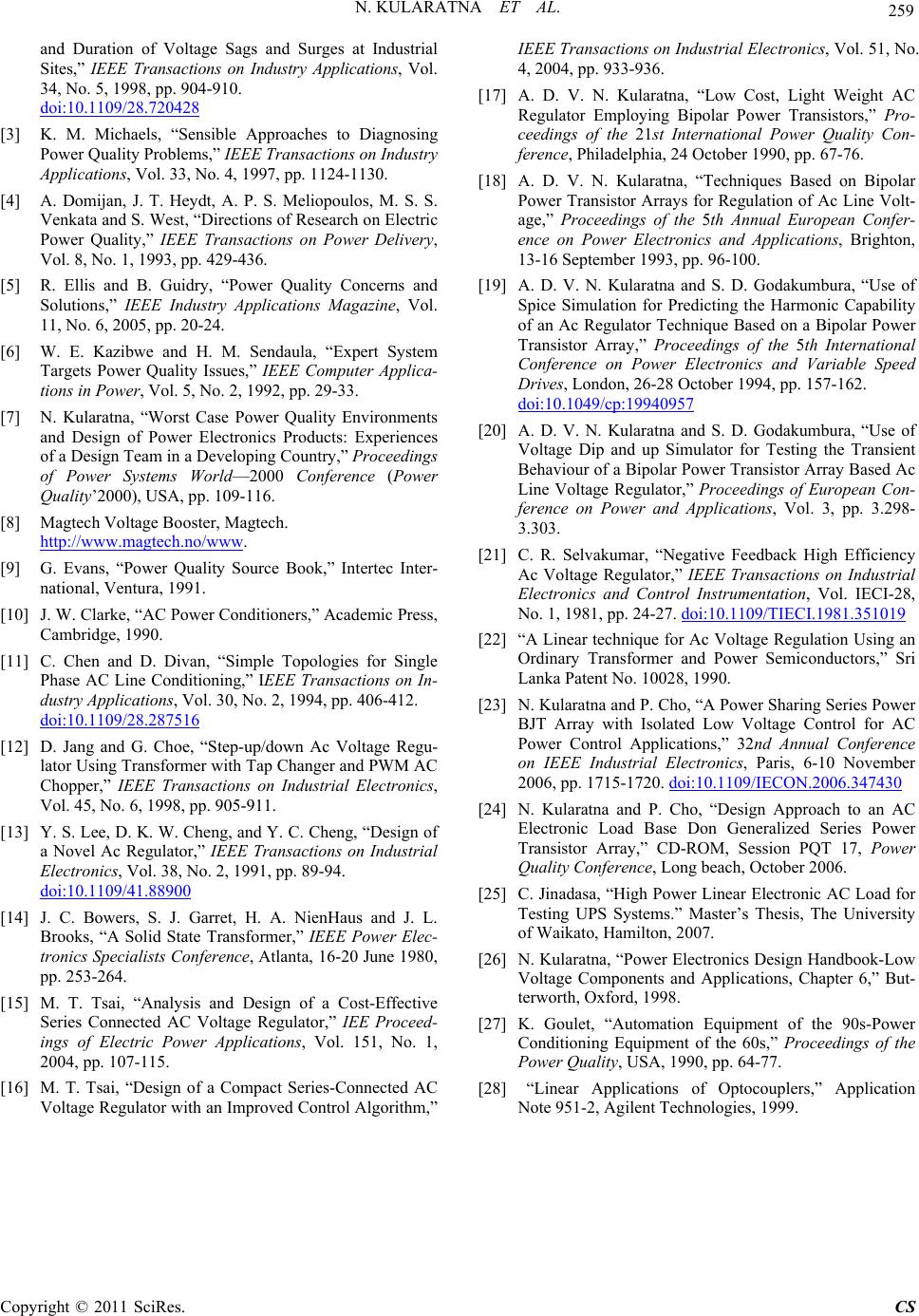
N. KULARATNA ET AL.
259
and Duration of Voltage Sags and Surges at Industrial
Sites,” IEEE Transactions on Industry Applications, Vol.
34, No. 5, 1998, pp. 904-910.
doi:10.1109/28.720428
[3] K. M. Michaels, “Sensible Approaches to Diagnosing
Power Quality Problems,” IEEE Transactions on Industry
Applications, Vol. 33, No. 4, 1997, pp. 1124-1130.
[4] A. Domijan, J. T. Heydt, A. P. S. Meliopoulos, M. S. S.
Venkata and S. West, “Directions of Research on Electric
Power Quality,” IEEE Transactions on Power Delivery,
Vol. 8, No. 1, 1993, pp. 429-436.
[5] R. Ellis and B. Guidry, “Power Quality Concerns and
Solutions,” IEEE Industry Applications Magazine, Vol.
11, No. 6, 2005, pp. 20-24.
[6] W. E. Kazibwe and H. M. Sendaula, “Expert System
Targets Power Quality Issues,” IEEE Computer Applica-
tions in Power, Vol. 5, No. 2, 1992, pp. 29-33.
[7] N. Kularatna, “Worst Case Power Quality Environments
and Design of Power Electronics Products: Experiences
of a Design Team in a Developing Country,” Proceedings
of Power Systems World—2000 Conference (Power
Quality’2000), USA, pp. 109-116.
[8] Magtech Voltage Booster, Magtech.
http://www.magtech.no/www.
[9] G. Evans, “Power Quality Source Book,” Intertec Inter-
national, Ventura, 1991.
[10] J. W. Clarke, “AC Power Conditioners,” Academic Press,
Cambridge, 1990.
[11] C. Chen and D. Divan, “Simple Topologies for Single
Phase AC Line Conditioning,” IEEE Transactions on In-
dustry Applications, Vol. 30, No. 2, 1994, pp. 406-412.
doi:10.1109/28.287516
[12] D. Jang and G. Choe, “Step-up/down Ac Voltage Regu-
lator Using Transformer with Tap Changer and PWM AC
Chopper,” IEEE Transactions on Industrial Electronics,
Vol. 45, No. 6, 1998, pp. 905-911.
[13] Y. S. Lee, D. K. W. Cheng, and Y. C. Cheng, “Design of
a Novel Ac Regulator,” IEEE Transactions on Industrial
Electronics, Vol. 38, No. 2, 1991, pp. 89-94.
doi:10.1109/41.88900
[14] J. C. Bowers, S. J. Garret, H. A. NienHaus and J. L.
Brooks, “A Solid State Transformer,” IEEE Power Elec-
tronics Specialists Conference, Atlanta, 16-20 June 1980,
pp. 253-264.
[15] M. T. Tsai, “Analysis and Design of a Cost-Effective
Series Connected AC Voltage Regulator,” IEE Proceed-
ings of Electric Power Applications, Vol. 151, No. 1,
2004, pp. 107-115.
[16] M. T. Tsai, “Design of a Compact Series-Connected AC
Voltage Regulator with an Improved Control Algorithm,”
IEEE Transactions on Industrial Electronics, Vol. 51, No.
4, 2004, pp. 933-936.
[17] A. D. V. N. Kularatna, “Low Cost, Light Weight AC
Regulator Employing Bipolar Power Transistors,” Pro-
ceedings of the 21st International Power Quality Con-
ference, Philadelphia, 24 October 1990, pp. 67-76.
[18] A. D. V. N. Kularatna, “Techniques Based on Bipolar
Power Transistor Arrays for Regulation of Ac Line Volt-
age,” Proceedings of the 5th Annual European Confer-
ence on Power Electronics and Applications, Brighton,
13-16 September 1993, pp. 96-100.
[19] A. D. V. N. Kularatna and S. D. Godakumbura, “Use of
Spice Simulation for Predicting the Harmonic Capability
of an Ac Regulator Technique Based on a Bipolar Power
Transistor Array,” Proceedings of the 5th International
Conference on Power Electronics and Variable Speed
Drives, London, 26-28 October 1994, pp. 157-162.
doi:10.1049/cp:19940957
[20] A. D. V. N. Kularatna and S. D. Godakumbura, “Use of
Voltage Dip and up Simulator for Testing the Transient
Behaviour of a Bipolar Power Transistor Array Based Ac
Line Voltage Regulator,” Proceedings of European Con-
ference on Power and Applications, Vol. 3, pp. 3.298-
3.303.
[21] C. R. Selvakumar, “Negative Feedback High Efficiency
Ac Voltage Regulator,” IEEE Transactions on Industrial
Electronics and Control Instrumentation, Vol. IECI-28,
No. 1, 1981, pp. 24-27. doi:10.1109/TIECI.1981.351019
[22] “A Linear technique for Ac Voltage Regulation Using an
Ordinary Transformer and Power Semiconductors,” Sri
Lanka Patent No. 10028, 1990.
[23] N. Kularatna and P. Cho, “A Power Sharing Series Power
BJT Array with Isolated Low Voltage Control for AC
Power Control Applications,” 32nd Annual Conference
on IEEE Industrial Electronics, Paris, 6-10 November
2006, pp. 1715-1720. doi:10.1109/IECON.2006.347430
[24] N. Kularatna and P. Cho, “Design Approach to an AC
Electronic Load Base Don Generalized Series Power
Transistor Array,” CD-ROM, Session PQT 17, Power
Quality Conference, Long beach, October 2006.
[25] C. Jinadasa, “High Power Linear Electronic AC Load for
Testing UPS Systems.” Master’s Thesis, The University
of Waikato, Hamilton, 2007.
[26] N. Kularatna, “Power Electronics Design Handbook-Low
Voltage Components and Applications, Chapter 6,” But-
terworth, Oxford, 1998.
[27] K. Goulet, “Automation Equipment of the 90s-Power
Conditioning Equipment of the 60s,” Proceedings of the
Power Quality, USA, 1990, pp. 64-77.
[28] “Linear Applications of Optocouplers,” Application
Note 951-2, Agilent Technologies, 1999.
Copyright © 2011 SciRes. CS